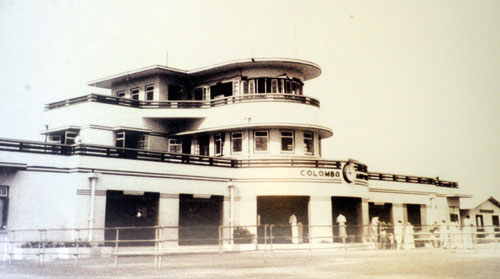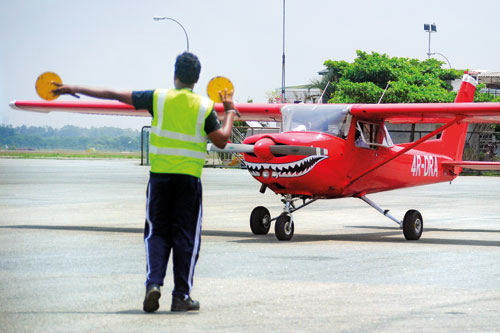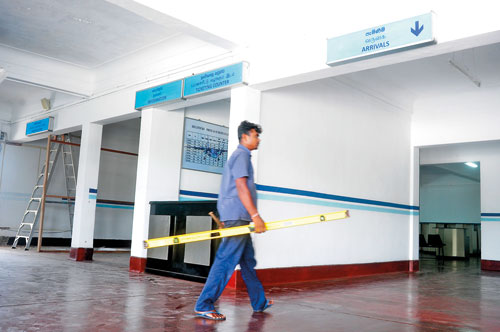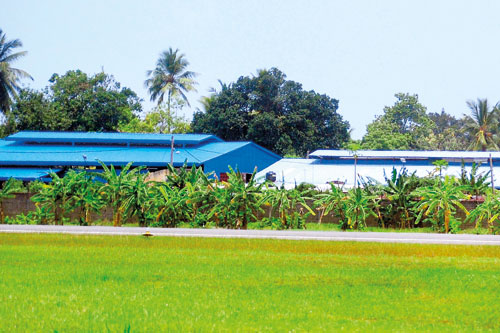Airport Aviation agency goes ‘bananas’ turning around Ratmalana

Old terminal
Sri Lanka’s first airport is set to get busy again with more commercial operations set to take hold as state plans get underway to develop the hub for the Colombo Airport Ratmalana as an international facility with required certification with no more “bananas” to hamper the progress.
The Ratmalana airport is set to become the next biggest development as it gears to be upgraded to entertain charter and scheduled commercial international and domestic flights.
The airport is set to become a 3C certified facility that could cater to A319, ATR, DH08 and other similar aircraft once the Civil Aviation Authority (CAA) carries out an audit and ensure compliance with international standards to obtain aerodrome certification, Airport and Aviation Services Airport Manager for Colombo Airport, Ratmalana Aruna Rajapaksha said in an interview with the Business Times at his office last week.
The runway at the airport needed to be maintained with obstacle clearance, mandatory manual, aircraft emergencies which are part of the compliance requirements that require international certification.
As the first international airport in the country in 1934, the facility operated to the UK, India and other charter and scheduled flights, Mr. Rajapaksha said.
He explained that at present as well the facility is being used for airline training and will in future become a domestic aviation training hub.
Several local private and commercial airline operators operate at Ratmalana. They are Cinnamon Air, Fits Air, Millennium Airlines, Daya Aviation, Fly Southern, Air Senok, Lakwin Aviation, Sakura Aviation, Fairway Aviation Academy and Asian Aviation.
In this regard as an aviation training centre, it has nationals from India, Bangladesh, Nepal and the Maldives making up 10 per cent of the 450 students.

Aruna Rajapaksha
Corporate attractions
The government decided in August 2012 to allow international corporate jet operations to land at the Ratmalana Airport on the 1773 metre length runway. This would now be further expanded to accommodate scheduled flights to the airport.
At present the airport does not handle cargo operations and currently there is no plan in this regard.
A marketing plan would be established to attract corporate jets from India, Maldives, European, Thailand and Singapore, the Airport Manager said.
During the 3-month temporary closure of the BIA runway earlier this year, the Ratmalana Airport had handled about 100 corporate jets compared to around 50 that it handles on an annual basis. Around 450 corporate jets fly into Sri Lanka every year.
He said the airport is capable of providing speedy clearance within just 15 minutes while continuing to maintain the regular features of a standard facility with customs, plant and animal quarantine in addition to exclusive services for customised requirements.
Commercial, scheduled operations
Aircraft carrying less than 100 passengers would call at the Ratmalana Airport in future with scheduled international regional flights being attracted from the Maldives and South India.
Mr. Rajapaksha observed that most Maldivians prefer to travel to the Ratmalana Airport and would want to stay in proximity to the airport with most flying in on Thursdays and departing on Sundays. Maldivians mainly visit Colombo for medical, educational and tourism requirements, he said.

Navigating
The Maldivian, the national carrier of the Maldives would commence 3 60-seater aircrafts as per the initial agreement. Dates of the commencement of these flights are yet to be decided.
In addition, the Flyme carrier, the domestic airline based in Maldives will also be operating initially two charter flights selling their packages from Gan Islands to Colombo, Mr. Rajapaksha said.
He also pointed out that there was a proposal to start operations to South India from Trichy and Chennai on an ATR aircraft by Jet Airways.
In the meantime, the apparel manufacturer, Brandix also operates delivery flights from the Ratmalana airport to Vishakapatnam- India on a regular basis.
Issues with SLAF presence
The Ratmalana Airport is said to be carrying a debt burden from the Sri Lanka Air Force (SLAF) that continues to operate commercial flights and uses the large scale hangars despite time being up for handover to the Airport and Aviation Services of Sri Lanka (AASL).
The AASL has come to an agreement with the SLAF over the handover of the hangars
During the war years (1983-2009) the SLAF established hangars taking up space of two hangars with a large capacity of 7367 sq feet, 42,000 sq ft and 36,900 sq ft.
This space is currently required to ensure the AASL could lease it to aircraft operators for commercial use that could be used as a profitable venture, Mr. Rajapaksha said.
He explained that these two hangars would be handed back to the airport management but delay in payment of its dues is a cause for concern.
Interestingly, the SLAF has established banana, guava and pineapple cultivation on a stretch of 500 metres by 100 metres property allegedly encroaching onto the AASL space and attracting birds that was not conducive to the operations of an international airport. These plantations are to be moved out as it was located in proximity to the runway strip.
Moreover, Mr. Rajapaksha complained that they could not claim any revenues from the SLAF run Helitours commercial flight operations.
“Earlier we had a war but now we have an economic crisis and must meet civil aviation requirements,” he explained.

Construction work
He pointed out that they made losses amounting to Rs.500,000 in revenues per month for landing and parking and according to the Government Valuer it was estimated that the SLAF had incurred losses for the airport management amounting to Rs.800,000 in revenue per month in terminal use.
At present about 70 per cent of the AASL revenues were generated from the domestic airlines operating but some operators like Fits Aviation were said to have made losses since they were unable to compete with the state-run Helitours. As a result, Fits Aviation, Mr. Rajapaksha said had stopped scheduled flights and was currently involved in other operations.
Helitours was said to be making use of the air field for commercial use including the terminal but not paying their dues for that or for water, electricity and even blocking space for commercial parking. Currently, they were operating three scheduled flights to Jaffna via China Bay.
SLAF was previously involved in carrying out commercial operations transporting civilian traffic but with the A9 route opening the passenger numbers had dropped from about 100,000 to 3,000 using air transport.
Another issue at the Ratmalana Airport is the inaccessibility of the second Eastern taxiway due to restrictions by the SLAF which has expanded into areas that are now needed by AASL if commercial operations are to start.
The requirement is to maintain 26 metres from the taxiway centre line that is not available today, it was explained.
A swimming pool complex has been constructed as well facing a rugby ground that is managed by the SLAF. The rugby ground is said to have conducted only two tournaments annually. The SLAF also has a soccer ground and a ground for recreation as well.
In future, the SLAF operations would be shifted to the Northern side of the airport but its base camp would continue to function in its present location.
In line with these changes, the existing nine hangars that AASL manages for its 11 operators and the taking over of the three large hangar space could be used based on the high demand from locals and foreign clients, Mr. Rajapaksha explained.

Banana plantation. Pix by Amila Gamage
SLAF Spokesman Group Captain Gihan Seneviratne responding to the allegations made by the AASL noted that regarding the Helitours operations there were no outstanding invoices.
He explained that the Helitours operation was carried out as a commercial operation in a limited sense to promote the field of aviation in Sri Lanka and whatever earnings were made were sent directly to the Treasury.
It was pointed out that the aircraft used were SLAF aircraft that were not required to pay any handling charges to the airport authorities.
On the other hand he noted that if the AASL believes they need to be paid that has to be addressed “but if they have not billed us then they should start invoicing and transfer of funds must happen from one ministry to another”.
Concerning allegations of encroachment of property at the airport, Group Captain Seneviratne explained, “We have never encroached and especially during the conflict have expanded with full sanction of the authorities which is for the security of the country.”
Commenting on the plots of land used to grow fruits, he explained that this was a common practice in any camp run by the SLAF in order to attend to their own requirements and pointed out that there was “no question of commercial operation being hindered by this growth.”
“If we are detrimental to the operation of the flights we are willing to make the changes required,” he said.
Figuring a story
As part of the development plans of the Ratmalana Airport, the management is looking at installing approach lights, Distance Measuring Equipment (that indicates the distance to the aerodrome) and Nautical Distance Equipment (a device that gives the exact location of the aerodrome).
In addition, in mid May the airport would introduce a GPS tracking system as well.
Current net profit annually is approximately Rs.3.5 billion with earnings in the range of Rs.3 million per day in revenues that includes charges levied from aircraft flying over the Sri Lankan air space.
During the Commonwealth Summit in Colombo in 2013, Terminal 1 of the Ratmalana Airport was upgraded at a cost of Rs.100 million while Terminal 2 is currently carrying out renovations at a cost of Rs.20 million for the basic modification changes that would include air conditioning and setting up counters.
Terminal 1 has been further expanded to include a VIP lounge in 2013 dedicated for Ministers, MPs, Secretaries and Diplomats and subsequently established a VVIP lounge for Heads of States and Prime Ministers. A Commercially Important Persons (CIP) lounge is also available for other visitor like businessmen visiting the country.
Terminal 2 that was also under the SLAF was handed back to the AASL as a result of which the renovation work is being carried out which would in future cater to the corporate jets and scheduled regional airlines.
The second terminal would also have a duty free facility and a bank counter as well, it was noted.
At present the Ratmalana Airport has no international certification and with the required standards made ready the facility would be able to attract increased scheduled and commercial operations to assist the incoming boost in traffic. With more jet operations set to fly into Colombo, Ratmalana would be a hub directly kick-starting the economic drive on par with the Colombo Port City developments as well as the thriving tourism industry.
| Ratan Tata used Ratmalana airport | |
| India’s powerful business magnate Ratan Tata had visited Colombo in early 2016 arriving at the Ratmalana Airport in his corporate jet. He is said to have arrived along with his architect to discuss the Krrish project in Colombo. The US$ 650 million-Krrish square project construction is now underway and the Krrish Transworks Colombo (Pvt) Ltd, local company of the Krrish Group signed a supplementary agreement with the BOI on November 29, 2016 to complete the project in 48 months. |


